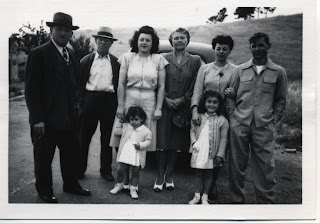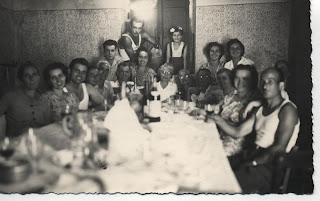Some years ago -- December 1985 to be exact -- I decided to create a unique Christmas present for my family. It so happened that we had the perfect storm of circumstances that propelled me to spill out sixty-two pages of family recipes in a matter of a long weekend. First, I was decidedly strapped for cash that year. Second, we had a huge snow storm that prevented transport in or out of our Wellington Hills home. Third, I was working in an agency focused on food. The result was "Favorite Family Recipes Cookbook." As I wrote in the introduction, "This cookbook combines the best cooking of the generations of the family Carignani" [my grandmother's family in Ponte-a-Moriano] who still cook exactly like my grandmother, mother and aunts and now myself, cousins, sister, and children still do today."
I began my cookbook with a trip down memory lane:
Christmas is rich with tradition in our family -- new and old. My memory extends far back to those Christmas Eves at Nonna's and Nonno's. Waiting for the car to arrive from Los Angeles so we could quickly get through the baccala and ceci soup to what was really near and dear to our hearts -- opening the presents. Christmas Day was feast day. The highlight simply was food. Everyone contributed to the feast.
We would start with antipasto: ascuiga (anchovies) with tomatoes, garlic and olive oil and good homemade wine vinegar from barrels in the basement, crostini (traditional with sauteed chicken livers), fried cardi (cardoons), artichoke hearts, marinated tuna, prosciutto, mortadella, coppa, provolone, crab with garlic, parsley and lemon. All served with large baguettes of fresh French bread.
Only after the antipasti could we go on to the ravioli's. After ravioli's ensalata (salad), meat dishes, roasted potatoes, sweet potatoes, cooked vegetables, and more that is now forgotten it was so many years ago.
Dessert was the finale with pumpkin, mincemeat, torta verdura, torta cioccolata, assorted biscotti, torrone, panforte and fresh fruits and nuts.
At each step of the way we were served homemade wine -- my father's and grandfather's -- a zinfandel from Parducci vineyards in Napa. Everyone had their favorite food of the day. Mine was the torta verdura (made with swiss chard). Nonno's was roasted chestnuts. (When I studied in Florence I understood why, in winter chestnuts are roasted all over towns and the hot nuts warm cold fingers and are very filling.) Being Italian is about family. It is often said that Italians are loyal first to their family, next to their town, then to their province, and last to their country.
Here are snapshots of my childhood:
The citron tree in Nonno and Nonna's back yard;
The old fig tree in which Nonno built our swing;
Their pomegranate tree;
Eating the lacey leaves of fennel in their garden;
The large redwood tank where the red wine was fermented;
Large wine barrels lined up in a row in the garage;
Ravioli's freshly made and drying on all available surfaces;
Small chicken eggs fresh from the day's chicken cooked in brodo (broth) for me to eat;
Chicken feet being singed on the gas burner and tossed into the brodo;
Focaccia from Lucca's delicatessan pungent with tomato sauce and anchovies;
Trading torrone boxes;
Eating confetti (sugar almonds) at weddings and the hours it took to wrap the white confections in netting and tie with satin bows;
Sleeping in the windmill at Zia Inizes;
Zia Racchele's purple mosquito ointment;
The grape arbor at the farm house in Merced;
Nonna's dry cured olives in large ceramic vessels;
Carboys of wine in the cellar;
Garlic around Nonno Eugenio's neck to ward off illness.
La Mia Famiglia
 |
| From left: Nonno Natale, Nonno Eugenio, Auntie Diva, Nonna Maria, Auntie Elvie, Uncle Ralph and bottom row: me (Denise) and sister Carole at our dead end on Sheldon Street, Oakland, California (c. 1947) |
 |
| Nonno and Nonna probably on the ranch in Merced, California |
 |
| My great grandmother and grandfather in Italy (unsure of year but probably late 1800s or early 1900s). |
 |
| My mother cutting a roast for an outdoor family pranzo. My father looking on from behind her. One of many I remember though I don't know if I was born yet here. |
 |
| The Carignani family in Porte a Moriano in front of the house that the family still owns and lives in. All but two of the people in this picture were alive and well when I lived in Italy in 1966-67. Many are still in Porte a Moriano still today. |
 |
| My grandmother on a visit to the relatives in Porte a Moriano in the mid 1950s. I've visited this formal dining room but have never eaten in it so this was truly an unusually festive occasion. I've always eaten in the kitchen which has a large cooking fireplace, large marble counters and is very warm and cozy. |
 |
| Again, my grandmother's visit with her brothers and sisters in front of her childhood home in Porte a Moriano. My grandmother is the one standing in the middle with the white blouse and white hair. |
 |
| The Cresci brothers on their farm in Merced |
 |
| From left (barely visible) is my Zia Assuntina (my grandmother's sister), Benediti (her husband), grandfather Natale (mother's side), girl unknown, grandmother (father's side) and grandfather Eugenio (father's side). |
 |
| Family portrait: my mother Etrikita (Henrietta as she was renamed when she began attending school because the other was too ethnic. Later her sisters would call her Kita and she would become known as Kate), me being held by my father, my father Gaudenzio (who would become known as Dan in America), and sister Carole. |
 |
| Parentis and Cortopassis. |
 |
| Nonno holding our hands (in front of our house in Oakland) |
 |
Nonno showing Italian machismo holding up his three daughters, from left Diva, Elvie and Kate while smoking a stoggie.
Our Family’s Raviolis Yields 800-850 raviolis
Ingredients for the filling: Meat 6lbs Tri-tip strip steaks 4-6 Center-cut boneless pork chops 6 Skinless/boneless chicken breasts Herbs+Spices+Veggies 1 ½ c Parsley (leaves only) 6-8 Cloves of garlic ¾ tsp Pepper 3tsp Salt 1tsp Allspice 1/8tsp Cloves 1 ½lbs Spinach Bread+Dairy 8 Slices white bread (crust removed) 8 Eggs 2 ½ c Freshly grated Romano cheese 2 ½ c Whole Milk Other Olive oil for cooking meats Pinch of rosemary for chicken.
Ingredients for the pasta dough: 10lbs Gold Medal All-Purpose flour 2tbl Salt 6tbl Olive oil 8 Whole eggs 6 Yolks 2 Quarts warm water
(Doubled from the original recipe as we have found that less does not utilize all of the filling)
Instructions for the filling:
Prepare the day before: - Season steaks well with herbs and roast at 350-degrees for 50 minutes.
- Season pork well and cook on top of stove until cooked through.
- Season chicken with rosemary, olive oil, salt & pepper and roast at 325-degrees for 30 minutes (or 20 minutes in a convection oven)
- When cool, cut in smaller pieces to fit meat grinder and refrigerate in individual sandwich bags.
- Retain liquids from the pans, combine, strain, and place in refrigerator to thicken, when chilled, remove fat and return to refrigerator.
- Wash and boil spinach. Drain well and refrigerate in container.
- Chop garlic gloves and refrigerate in sandwich bag.
Morning of: Prepare the pappa - Cut crusts of bread, tear into pieces and place in 3-quart pan. Pour all of the milk on the bread and let soak through.
- When soaked, add 1 cup of the meat liquid and cook on low heat stirring constantly for 8-10 minutes or until the texture is smooth and creamy. Set aside.
- Beat all of the eggs with an electric mixer.
- Add the Romano cheese, salt, pepper, allspice, cloves and the pappa to the eggs. Put in the refrigerator until ready to use.
Communal effort: First prepare the pasta dough - Pour onto a clean surface, ½ of the flour.
- Make a well in the center and add the eggs, olive oil and salt.
- Incorporate the water adding a little at a time.
- Add the flour a little at a time until only ¼ of the flour remains.
- Rub flour on your hands and make a smooth ball with the dough.
- Knead the dough for approximately 1 hour (minimum) or until the ball is smooth as a “baby’s bottom.” It will feel silky and smooth.
- Let rest for 1-2 hours.
Meanwhile prepare the filling - Using an electric meat grinder, alternate grinding the steak, chicken, pork, spinach, garlic, parsley and remaining meat liquid. Continue until all of the ingredients are ground and mixed.
- Add pappa mixture to the meat and blend well with your hands.
- Taste for seasoning and add Romano cheese, spices, salt and pepper as needed.
LUNCH BREAK With these crucial steps done, now is the perfect time to take a lunch break.
Making the raviolis - Divide the dough into 4 equal balls.
- Give four groups of ravioli makers one ball each.
- Feed the ravioli dough through the pasta machine (according to instructions, calibrate the thickness of the final pasta sheet with each other so that the cooking time will be the same, making sure the dough is neither too thin nor too thick)
- Make 2 sheets of dough, laying one on the top of the ravioli mold.
- Add walnut-sized filling to each ravioli.
- Cover with the remaining sheet and roll with rolling pin until the metal peeks through the pasta.
- Turn the mold over onto a well-floured cloth or wax paper.
- Separate each ravioli by hand or with a rolling wheel.
- Place on a cookie sheet and quick freeze for about ½ hour.
- Place into large zip-lock bags when frozen.
- Return to freezer.
- Repeat process until all of the dough and filling are used.
Hints - Have plenty of large freezer bags on hand;
- Cardboard to separate the layers of raviolis in transit to a freezer useful, and a large cardboard box to transport them in as well;
- Wax paper;
- Clean dish towels;
- Clean surface, such as a heavy cutting board, to knead the dough and
- Four pasta machines and a division of labor with two people making the dough; and two people filling and cutting.
- Ask 4 people to bring pasta machines and rolling pins, and everyone should bring their own apron.
- Lunch should be a hearty stew that can be made the day before, with plenty of French bread, wine, and biscotti for dessert.
Estimated time allowance for the entire process - Day before: 4-5 hours total with 2 hours of shopping (Costco has everything necessary) and 2-3 hours for the cooking.
- Morning of: 1-2 hours for the pappa to soak, cook, cool and then to add other ingredients.
- Dough: 2-3 hours with 1 hour to knead and 1-2 hours for the dough to rest.
- Filling: ½ - 1 hour to grind the ingredients together.
- Making 800 raviolis: 3-4 hours depending on the number of people helping
Total estimated hours: 10 ½ - 14 hours with 6 ½ - 10 of those hours needed day of. |
















No comments:
Post a Comment